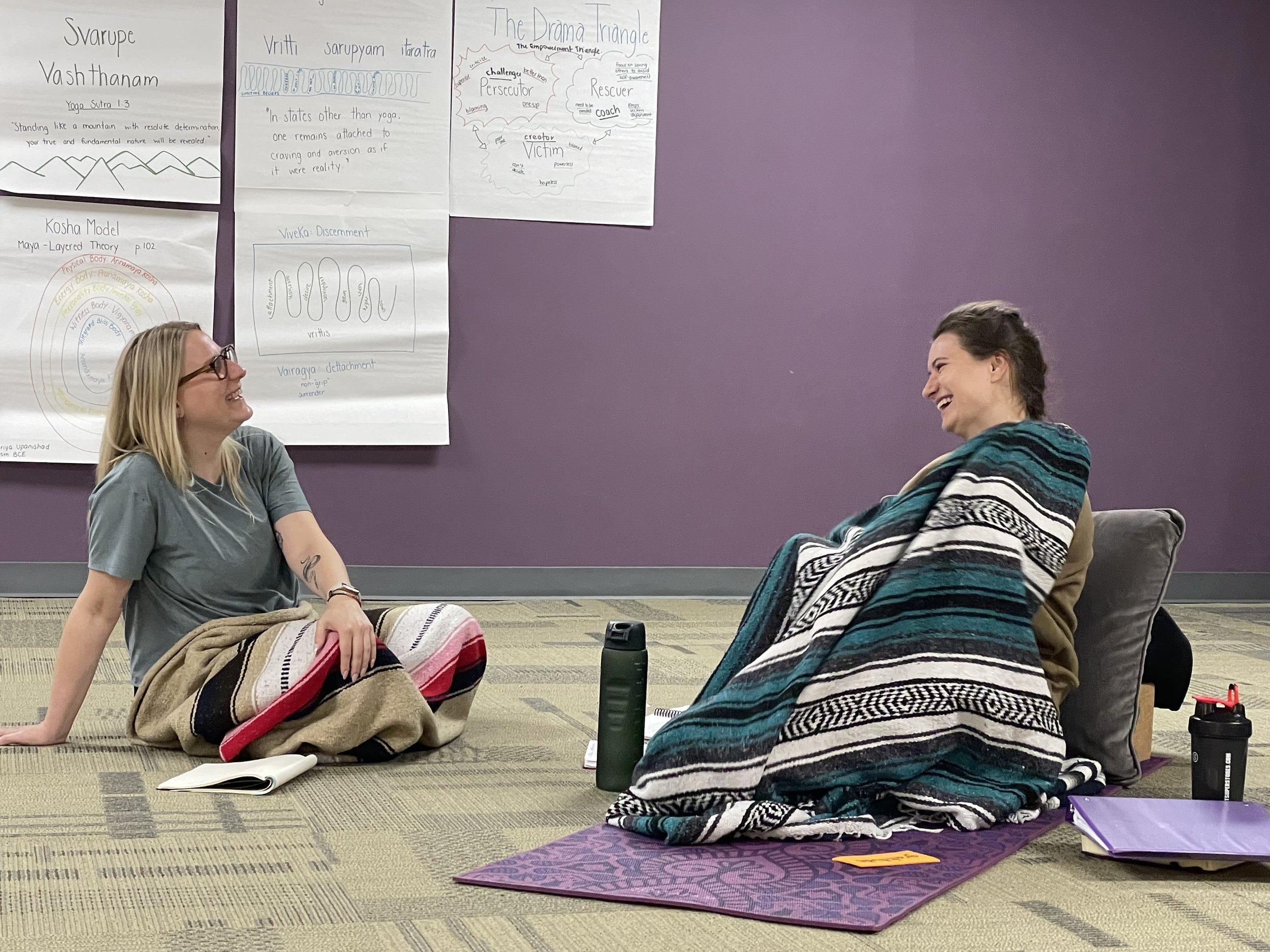From Information to Transformation: How Yoga Teacher Trainings Create Meaningful Change
In the landscape of adult education, there’s a profound distinction between the passive intake of information and the kind of deep, transformative learning that reshapes how we see ourselves and the world. Wisdom traditions teach that miracles are shifts in perspective—the "aha moments" that invite us to see from a new angle. Yoga teacher trainings (YTTs) are more than educational courses; they extend beyond instructing students on posture mechanics or breath control. Instead, they become transformative containers—spaces where those who step into the process with an open heart and mind can experience genuine shifts in how they move, think, and relate to themselves and the world.
200-hour Yoga Teacher Trainees exploring “pada-bandha” - the sole of the foot and how it supports overall balance.
Information Input vs. Transformative Learning
Traditional learning methods often focus on the input of information—acquiring knowledge, memorizing concepts, and practicing skills. In many fields of study, this method works well. You learn facts, apply formulas, follow protocols, and develop proficiency through repetition. Brazilian educator Paulo Freire called this the "Banking Method of Education," where teachers deposit knowledge into students as passive recipients. However, when it comes to yoga—an embodied, philosophical, and spiritual practice—the learning process often invites a deeper kind of change. While this traditional model of education assumes knowledge is something transferred from teacher to student, learning that truly transforms a person requires something deeper—active engagement, self-inquiry, and a willingness to question one’s assumptions. This is where Transformative Learning Theory comes in.
Transformative Learning Theory, introduced by Jack Mezirow, suggests that true learning happens when individuals experience a shift in their worldview. The first time I heard about this theory it was through one of my dear mentors and teachers, Janel Schullo MD, director of Nexus Yoga Institute. This type of learning requires self-reflection, critical thinking, and often, a moment of disorientation or challenge that pushes the learner into new ways of understanding themselves and their relationship to the world.
Trainees during the 200-hour Yoga Teacher Training engaging in a group discussion.
Why Yoga Teacher Trainings Are Transformative
Unlike a conventional classroom setting where students absorb information and regurgitate it, a well-designed YTT fosters an environment where learning is embodied, experiential, and deeply introspective. Here’s why:
1. Self-Inquiry as a Core Component
YTTs encourage students to examine their inner landscapes. Through philosophy explorations, group discussions, and self-reflection exercises, students explore personal beliefs, habits, and emotional patterns. This process itself can be transformative, as it brings unconscious tendencies to the surface for examination and potential change.
2. Embodiment of Learning
Yoga is learned through the body, breath, and direct experience. Unlike theoretical education, which remains intellectual, YTTs engage participants in felt experience—moving, integrating concepts somatically, and even refining how they use their voice. Embodied learning fosters lasting change by rewiring patterns of how we move in space and present ourselves to the world.
3. Challenging Assumptions & Expanding Perspectives
Many who step into a YTT come with preconceived ideas about who they are and what yoga is (or isn't). Engaging with yogic philosophy, ethics, and the deeper dimensions of practice often challenges these assumptions, expanding students’ perspectives on what it means to live a yogic life and how to share that with others from an informed and respectful place.
4. The Power of Community & Shared Reflection
Learning in a collective environment where deep conversations, vulnerability, and shared experiences are welcomed allows for transformation to unfold organically. The relationships built in a YTT create a container of trust, enabling students to explore their edges, dismantle limiting beliefs, and step into their authentic selves.
5. The Disorienting Dilemma
Mezirow’s theory highlights that a key catalyst for transformation is what he calls the ‘disorienting dilemma’—a moment where previous ways of thinking no longer make sense, forcing the individual to reconstruct their worldview. Many YTT students experience these moments—whether through the challenge of facing their own resistance, encountering yogic wisdom that reframes their values, or simply by realizing that there is more to yoga and themselves than what they originally thought. This process engages neuroplasticity—the brain’s ability to rewire itself through new experiences and learning.
TYI Co-Director, Prema E-RYT 500, facilitating a discussion on the histories of yoga.
The Impact of Transformative Learning in YTTs
A well-structured yoga teacher training does more than prepare someone to teach asana poses and breathing techniques; it invites them into a journey of authenticity through self-discovery. The real impact of YTTs lies in the mentor’s skillful ability to support students as they navigate personal transformation, offering tools for self-regulation, self-expression, presence, and space for integration.
When approached with curiosity and willingness, yoga teacher trainings become a space where students not only learn to guide others but also to step into a deeper understanding of themselves and the world. It is in this alchemy—where information is not just absorbed but embodied and questioned—that transformation takes place.
TYI Co-Director, Julianne RN C-IAYT E-RYT500, engaging with a 200-hour trainee on an exploration of the unique anatomy of shoulders.
Conclusion
In a world where education is often reduced to the mere transfer of information, yoga teacher trainings stand as a powerful example of transformative learning in action. They provide students with more than just knowledge; they offer a framework for inquiry, a space for growth, and an opportunity for true transformation. Whether or not a student chooses to teach afterward, the learning gained in a YTT has the potential to reshape their life in profound and lasting ways.
When we recognize YTTs as more than certification programs—embracing them as deeply transformative journeys—we honor the true essence of yoga: a path to connection, self-awareness, and meaningful change. What if we approached all opportunities to learn this way—not just as the accumulation of knowledge, but as an invitation to transform?







